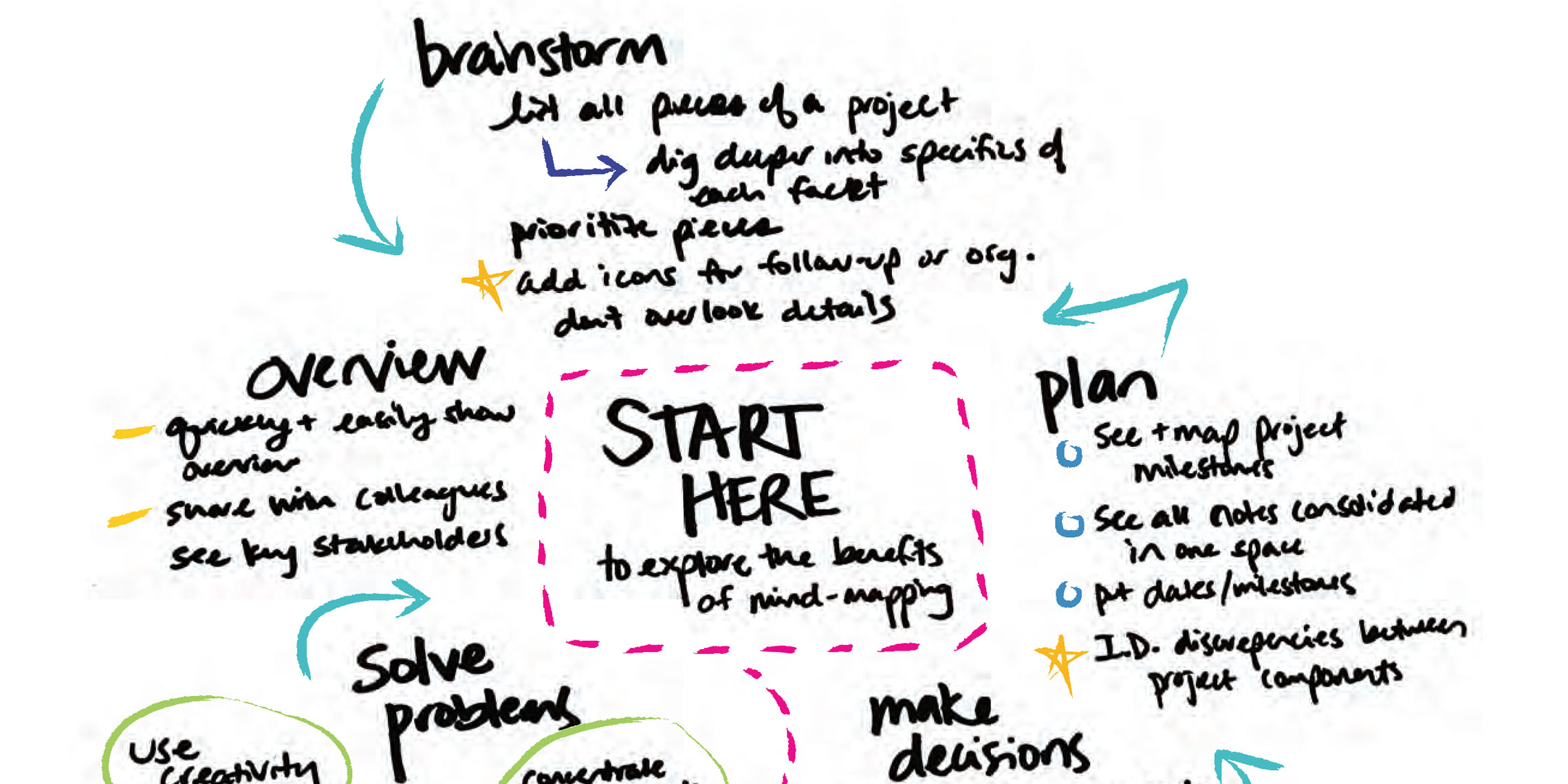
Published on August 18, 2016 |
Article updated 5/04/17
Mind-mapping—the creative process of free-form identification—isn’t just a tool for figuring out your life’s plans. This design-thinking tool can help you and your team solve project management dilemmas.
Project management keeps your business in balance—predicting upcoming costs, checking the scope of work against available resources, and ensuring deadlines are met. Project managers keep the ship afloat, so to speak, and make sure all hands are on deck—and on time—for work.
If you’re faced with a problem to solve, concept to grasp, or project to plan, mind-mapping helps collect all ideas and interests to start a clear organization process. A mind-map is a visual representation of a project’s components—in other words, it’s a chance to write or draw all of the connected pieces of a project or single concept.
Josette Galiano, co-founder and executive director at the Institute of Healthcare Design Thinking, says mind-mapping helps her see the big picture of a project and immediately evaluate necessary connections and resources.
“Mind-mapping is a blank canvas that allows you to focus on a main idea and give yourself space, literally and figuratively, to explore that concept,” she says. “This practice enables me to visually represent everything related—or not—to a project. It’s a sense of relief getting all of that information on a page. From there, you can organize it and identify next steps.”
To start mind-mapping, use a piece of paper—Galiano recommends a big one. Write the project, concept, or creative topic in the middle of the page. Identify and write all of the moving pieces and parts, including resources, responsibilities, perspectives, deadlines, expectations, and obligations.
Collaborate with colleagues who may bring alternative perspectives. Set a time period—say, 30 minutes—to “dump” all related thoughts on a page. This process will likely reveal areas of opportunity, new or different problems, or more efficient workflows.
“It’s easy to jump to reliable spreadsheets, but we need to take a step back and look at the thinking behind the projects and processes,” Galiano says. “This organic, free-flowing process ensures a fresh perspective and considers future opportunities rather than automatically jumping back to what was done last time.”
Mind-maps can be used around any single-focused plan or project, such as a financial plan or management process. Galiano uses it to plan workshops. She emphasizes the importance of using a mind-map before turning to traditional project management tools, software, and layouts.
“Instead of boxing myself into a database tool or spreadsheet, mind-mapping provides an open, organic space outside of applied structure,” she says. “When you jump right into a spreadsheet, you’re trying to fit creative ideas into a prepared structure. You’re trying to organize ideas as they’re emerging. Mind-mapping is a necessary—and helpful—step to ensure you’ve thought through all facets of a project and considered all possibilities before moving into a template or spreadsheet for project management.”
Start with a project brief. This provides a sense of structure, or boundaries of a project or concept, to work within.
Don’t shrink your thinking. Galiano recommends using paper so you can refer to the mind-map later. Use paper bigger than the standard legal size so you’ll have a bigger canvas to think and connect freely.
Start with a single color. Galiano prefers to use black ink to start, and then goes back and uses different colors to organize and group different pieces. “Later you can create a color key for yourself and highlight relevant parts,” she says. “If you start using different colors, you prematurely organize information instead of it being totally free-flowing.”
Set a time limit. Mind-mapping can be done in as little as 10 minutes, 30 minutes, or an hour. This outsidethe-box thinking is a good way to break up the workday.
Involve other parties. Other people bring perspectives you may not have considered. You’ll be challenged to see a problem or project from a different point of view.
Identify high-level divisions. With information you’re organizing, consider the most pressing obligations, such as resources, budget, timeline, involved departments, or deliverables.